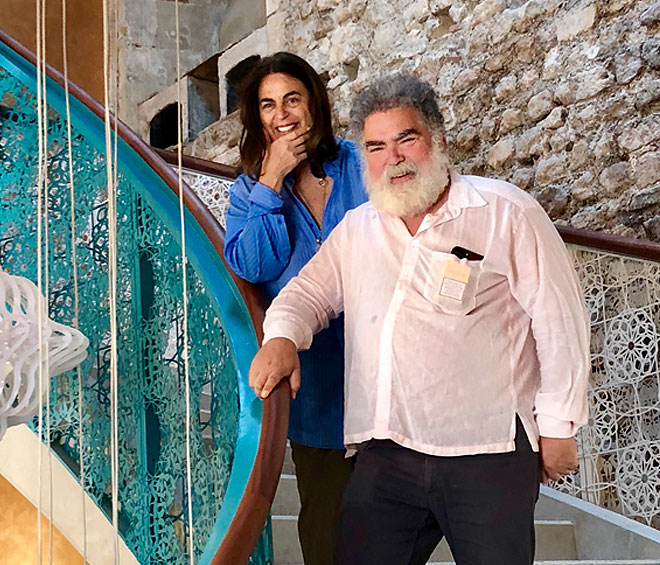
by VERONICA SIMPSON
It is hard to get one’s bearings stylistically, aesthetically, sociologically, even emotionally, while experiencing the hotel L’Arlatan in Provence, the latest work of art from the Cuban-born American artist Jorge Pardo (b1963). References, colour palettes and furniture styles mesh and collide with an exhilarating lack of interest in the interior design orthodoxies of the day (or, indeed, any day). I sit down to breakfast at a table made from the slenderest slice of pale-pink marble. My seat, an original, white Eero Saarinen dining chair with an orange cushion, faces a sofa of velvety chartreuse and a wall of wooden panels perforated and layered into a hyperreal handpainted landscape suffused with rich corals, ochres, indigos and khakis.
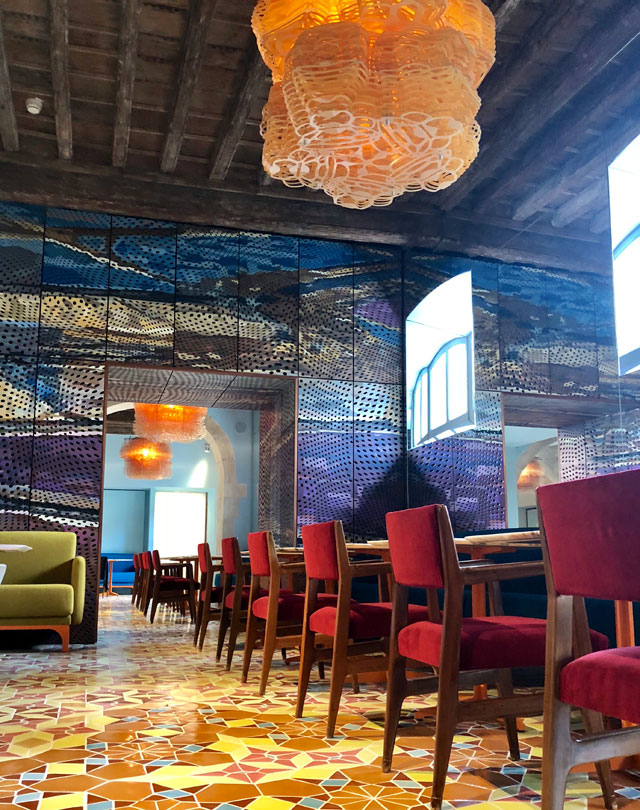
Jorge Pardo, hotel L’Arlatan, Arles, restaurant. Photo: Pierre Collet.
Spilling across the floor of this restaurant – and every floor surface throughout the hotel, including its outdoor pool – is an eye-boggling variety of ceramic tiles: kaleidoscopic, intersecting geometries of brown and yellow and pink are interrupted by flashes of greens and blues before morphing into a wholly different arrangement of hues. It only adds to the delicious eccentricity of this sumptuous, cave-like interior to be told that it was previously a car park.
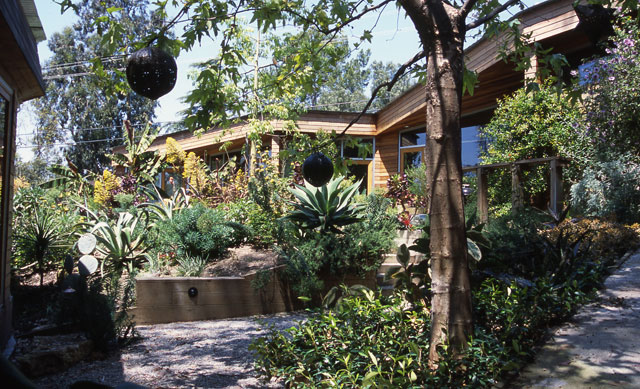
Jorge Pardo, 4166 Sea View Lane, Los Angeles. Photo courtesy Jorge Pardo.
Pardo is an artist who loves to step outside the space of the gallery to challenge our notions of what art might look or feel like. Perhaps his best-known work is 4166 Sea View Lane, an unusually inward-looking wooden house he built (and partially self-funded) in Los Angeles for the Museum of Contemporary Art; the house opened to the public for five weeks as an exhibition in 1998, and then Pardo moved in. Famously interested in interrogating “domestic public space”, he has subsequently created extraordinary bars and even private houses for a handful of public and private clients. But the 5,000-sq-metre L’Arlatan is a whole different proposition.
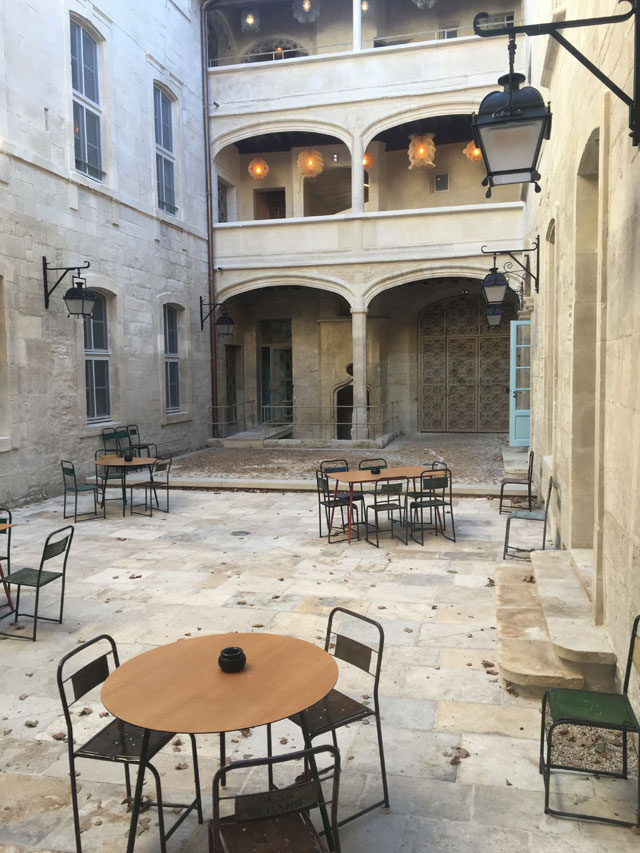
Jorge Pardo, hotel L’Arlatan, Arles, historic courtyard. Photo: Veronica Simpson.
His invitation to transform a tired three-star hotel in Arles came in 2014 from the art-loving pharmaceuticals heiress Maja Hoffmann, who is masterminding the reinvention of this historic Provençal town as a place of cultural production as well as consumption (it has impressive Roman ruins, the Fondation Vincent Van Gogh – a new modern art museum focused around the region’s most famous visiting artist – and the annual photography celebration Les Rencontres d’Arles). The main focus of her energy and investment is the Parc des Ateliers, a vast campus of disused train engineering sheds on the edge of the town, currently partway through refurbishment as spaces for exhibitions, residencies and multidisciplinary research. And L’Arlatan is vital to attract the cultured, sophisticated visitor Arles will need to attend its growing programmes, as well as to accommodate all the artists she invites to spend time here; L’Arlatan includes six artist residency units.
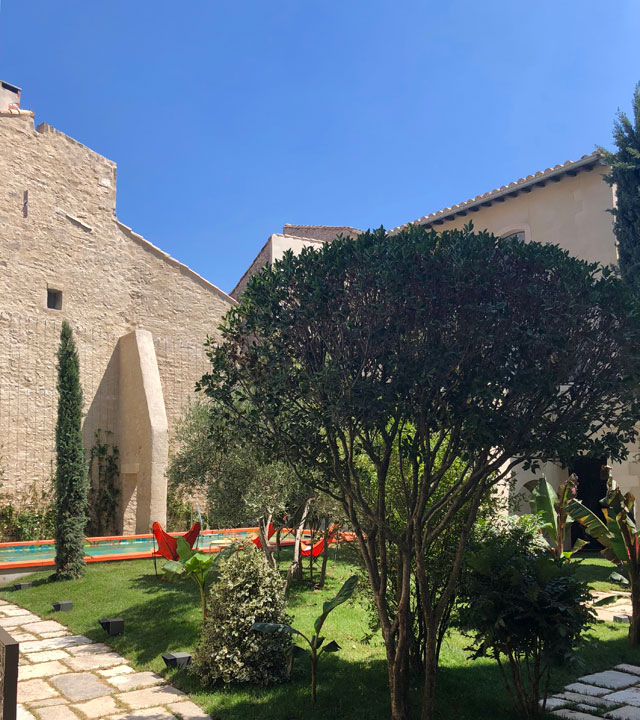
Jorge Pardo, hotel L’Arlatan, Arles, garden pool. Photo: Hervé Hote.
The hotel structure is a hotchpotch of styles and periods, comprising a 15th-century palace once belonging to the counts of Arlatan de Beaumont, the remnants of an ancient Roman basilica and a classical facade on three levels from a rebuilding scheme in the 18th century. Its retained assets include painted wooden ceilings from the 15th century and a monolithic column from the fifth. It is fascinating that Pardo’s response to this patchwork of eras and owners was to carpet every surface in a promiscuous palette of colour and texture. But his skill lies in both blurring and exposing the joins – celebrating the moments where ancient and modern collide, such as where a new helical concrete staircase rises up past the crumbling wall of the ancient basilica.
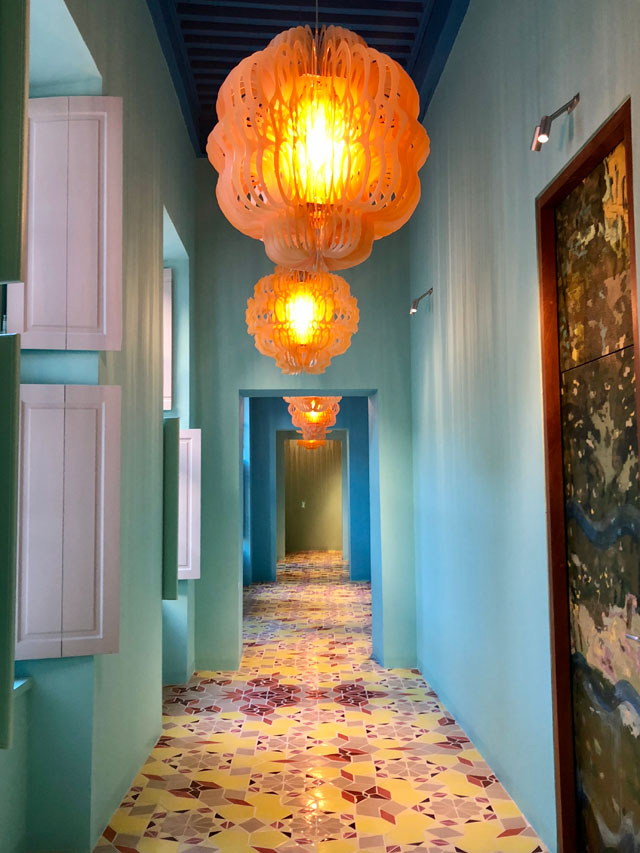
Jorge Pardo, hotel L’Arlatan, Arles, corridor. Photo: Pierre Collet.
Pardo’s signature is palpable in every nook and cranny, from the unlikely colours painted on the walls of each corridor, bedroom or living room wall to the frilly, flirtatious, laser-cut lamps designed and made by his studio. Hoffmann apparently asked for a Gesamtkunstwerk, and she certainly got it. Pardo and his Mexico studio team of 14 (expanded to 20 for this project) took three years to design and make almost every item in the 34-room hotel, from the 1,300 pieces of furniture to the 400 original Pardo paintings on wood, layered on to the doors of every bedroom, bathroom, wardrobe and minibar. He took time out to discuss this creation with Studio International just before the end of 2018.
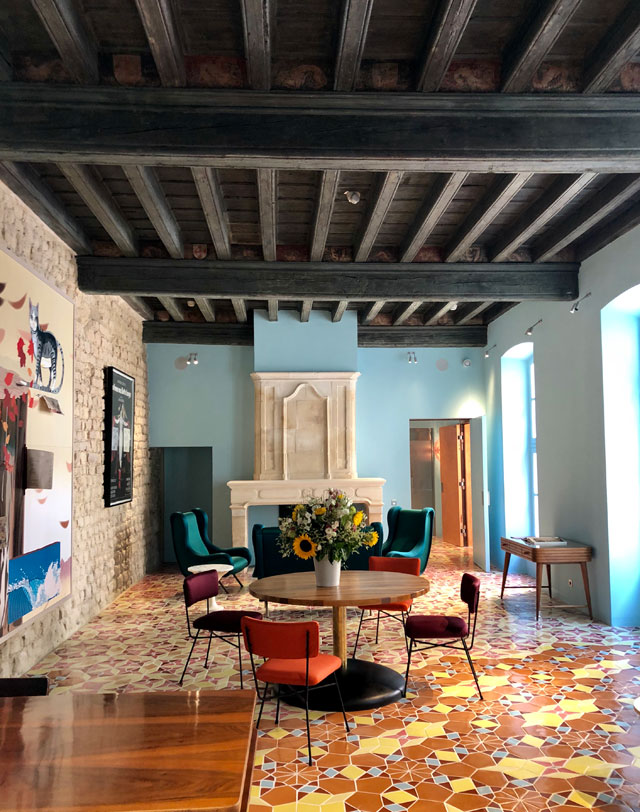
Jorge Pardo, hotel L’Arlatan, Arles, lounge. Photo: Pierre Collet.
Veronica Simpson: You said in an interview with Lane Relyea (in Phaidon’s Jorge Pardo monograph) that you were inspired by Robert Smithson to think beyond the exhibition space and see art “as part of a larger circuitry of things”. Clearly, L’Arlatan has expanded your opportunities to play within a different kind of circuitry. What were the most exciting areas of exploration and the most challenging?
Jorge Pardo: In general, what was most interesting was most challenging. Really, it was the degree to which it sustained my intention for it to be an object for display, an exhibition. I had to ask myself: is the work different enough, say, from a typical boutique hotel? Basically: why is this an artwork? And you have to say there is something in this project, because of my position, or Maja’s position as a patron, that begins differently from most hotels. That difference is a fine difference. It’s not even an explicit difference. Actually, when things are like that I find them much more interesting than when you have a more didactic hotel scenario.
.jpg)
Jorge Pardo, hotel L’Arlatan, Arles, bedroom. Photo: Hervé Hote.
VS: But as a guest staying there, one of the things that is most marvellous is the scale of the tile work – 6,000 sq metres. It feels more flamboyant, more ambitious than any interior designer would conjure – or be allowed to conjure. Partially, one feels, because they would not have had the budget. Was it a particularly generous budget?
JP: It was a good budget. We’d bump up against it. Maja’s very used to working with artists, and it’s not all the money in the world, but you do things and discuss how you want to do things. This [producing the tiles, which were made in Mexico] would not have been possible in Europe. Every project has challenges over budgets.
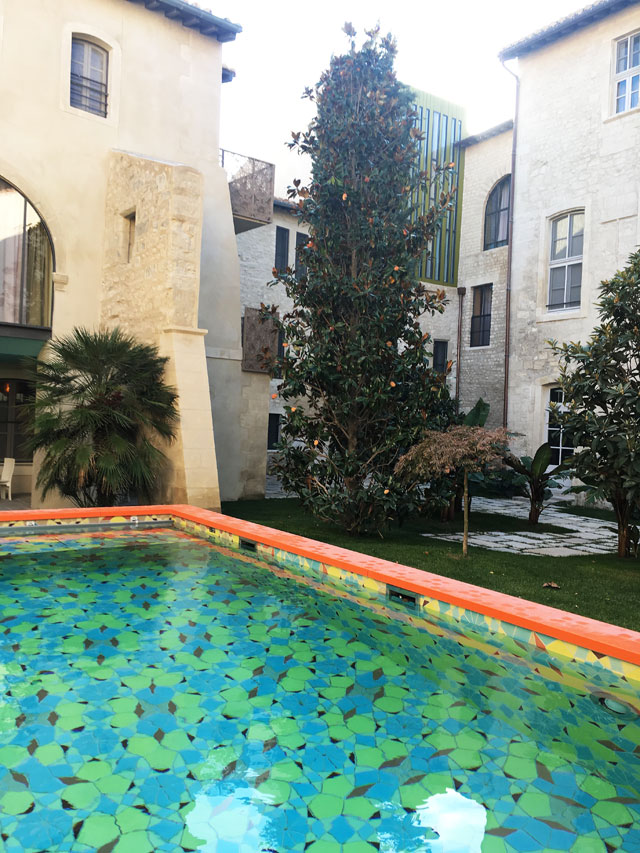
Jorge Pardo, hotel L’Arlatan, Arles, swimming pool in the garden. Photo: Veronica Simpson.
VS: You have talked of this carpet of tiles as an early inspiration, as a unifying feature across these diverse structures.
JP: The buildings are so haphazard. There are lots of different floor levels and stuff - all these areas where you have to go down to go up, and hundreds and hundreds of things that have to be covered. It was really strange, like a monster of a thing with a whole lot of restrictions. You didn’t know what you could or couldn’t do until you started with demolition. There was a lot of looking at stuff and going: “We’ve got to keep that.” There’s always negotiation. It was like, you have a choice: revealing things or covering them up. There was a lot of stuff that was discovered, a lot of it very usable, very interesting. It wasn’t just like: “Oh, another Roman arch shows up.” We found these whole rooms with paintings from the 15th century and a couple of funky Roman things. They are nice to show. It was always a negotiation with the department of Arles, which administrates the historical legacy.
The floor is like a unifying background. It suggests, this is quite ridiculous: everywhere you go, this floor is going to go with you.
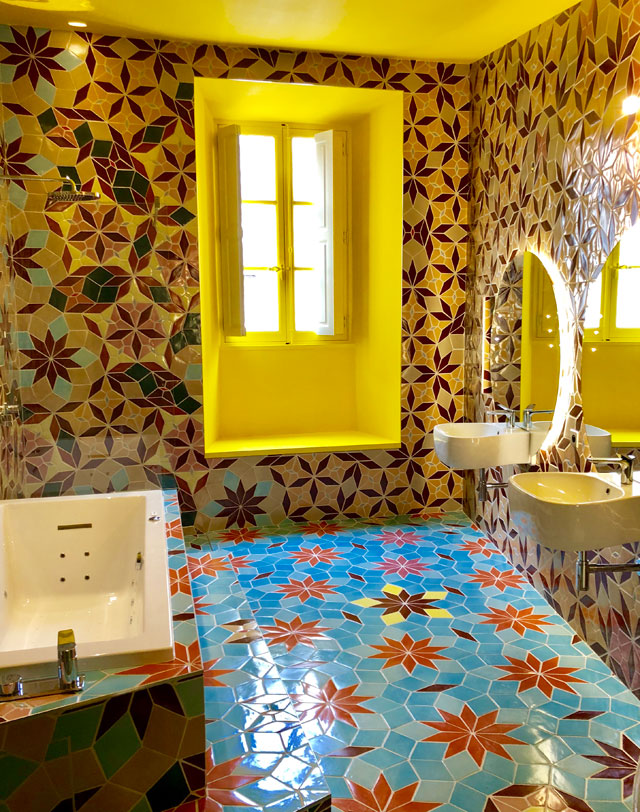
Jorge Pardo, hotel L’Arlatan, Arles, bathroom. Photo: Pierre Collet.
VS: The tiles are just one part of an incredibly complex, colourful, mixture. How did you work out the balance of detail and material and ornament, or was it more intuitive?
JP: It was more intuitive. We ended up doing stuff and the stuff that worked became like a platform for something else. And the stuff that didn’t work got kicked out. We have a lot of doors in the hotel. We thought it would be nice to use the building as a framework, as a ground for these paintings.
VS: Part of the beauty of these painted doors, however, is that these are original paintings by you but, because they are on doors, people get to touch them every day, which they would normally never be allowed to do.
JP: Yes, and they have to walk through them and the paintings are going to get scratched and they are going to collect the history of people who stay there. They are part of a body of work that dissolves, which is similar to the problem of 400 Van Gogh paintings (that we know of) that are no longer there. Then it was just a matter of doing one thing at a time. Three years go by and you end up with a hotel that does a bunch of interesting things.
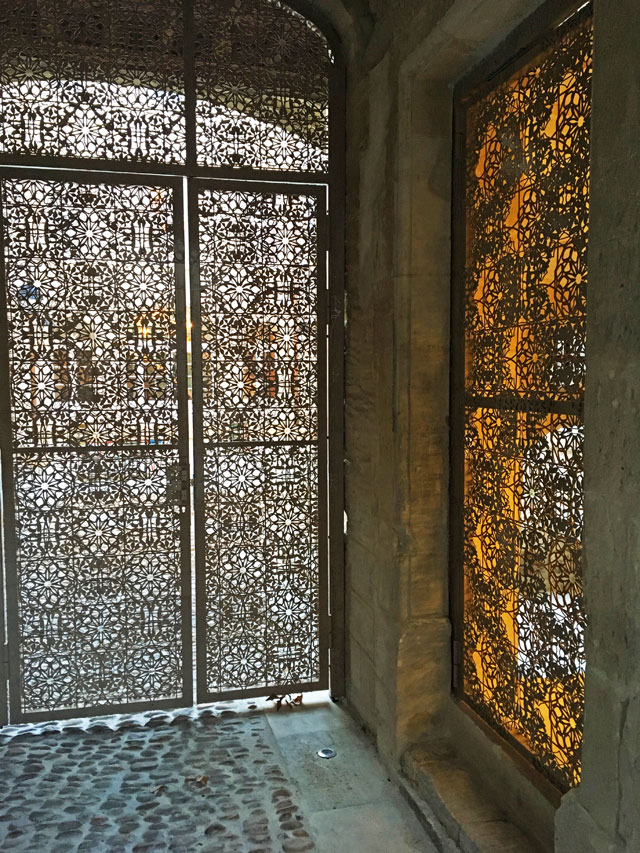
Jorge Pardo, hotel L’Arlatan, Arles, entrance porch. Photo: Veronica Simpson.
VS: What drove your decisions about which aspects to keep and which to discard – the decision, for example, to build that new, helical concrete staircase next to an original basilica wall?
JP: The staircase was meant to be in a different place, and we moved it there next to the basilica wall. Previously, the staircase was on the side, and it wasn’t particularly interesting. This was a three-storey space and I thought we needed to reshape it, to make it part of the circulation. I did about 90% of the architecture also. The architect [in Arles] facilitated us very well, but we needed to control how we did the circulation, it was the only way we could make the contrast or connections between the different spaces work.
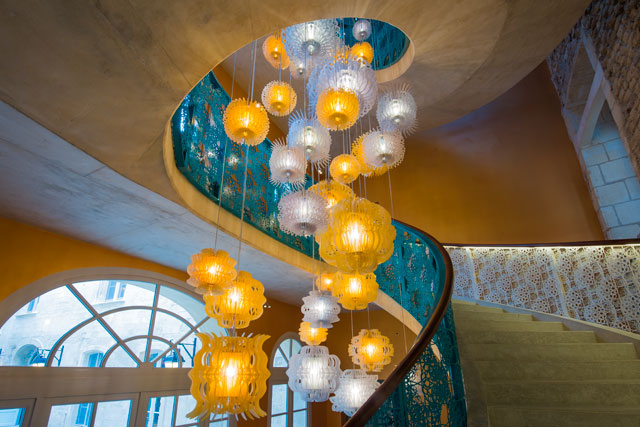
Jorge Pardo, hotel L’Arlatan, Arles, staircase. Photo: Hervé Hote.
VS: You have said that aspects of the interiors were inspired both by the Yucatán in Mexico, where your studio is based, and by the Camargue region, around Arles. What are the similarities and differences?
JP: What they have in common is they are both areas with large estuaries. There are large swamps that are incredibly productive and have a ridiculous number of birds, fish and wildlife. There are flamingos in both places. The Yucatán is also a very old place. You speak about antiquity differently in Mexico. But the antiquity goes way … beyond the Roman Empire. The Mayans were around for thousands and thousands of years. You can’t go very far and not dig up something, find a crazy ruin that sticks up out of the ground. The history of one is very codified, the history of the other is a bit confused. But these are full-blown civilisations … The Mayans invented a way of keeping track of time, which we still use today.
VS: Were these regions the inspiration behind the incredibly rich colour palette?
JP: The limitations of the colour palette comes from the factory where the tiles are made. We had certain requirements for the tiles to be really hard and durable: the closer the clay gets to glass, the harder it is, and the more durable. When you do that, the consequences are you lose a lot of colour. To prevent that happening you have to cook it super-hot, for super-long periods. You don’t get as bright a pink as you could. That became a problem, how you set up a palette with proper relationships that make these limited number of colours and how you pair them and use their patterns so that they jump as opposed to sit.
.jpg)
Jorge Pardo, hotel L’Arlatan, Arles, bedroom. Photo: Hervé Hote.
VS: But you were able to intensify colours in fabrics or the lamps, for example, to make the colours jump out.
JP: The colours are not so important. It is the construction of a set of relationships that work in a certain way: if they produce enough pleasure, you get lost in those relationships.
VS: One of the surprising things I learned is that Maja Hoffmann supplied her own collection of vintage 20th-century furniture to this hotel scheme. Did you know that you would be able to use this iconic furniture in the hotel at the start?
JP: We talked about the fact that I would make things, and she had lots of great stuff, and we said we should mix it up. I never wanted the place to be … one type of thing. I don’t think that’s interesting.
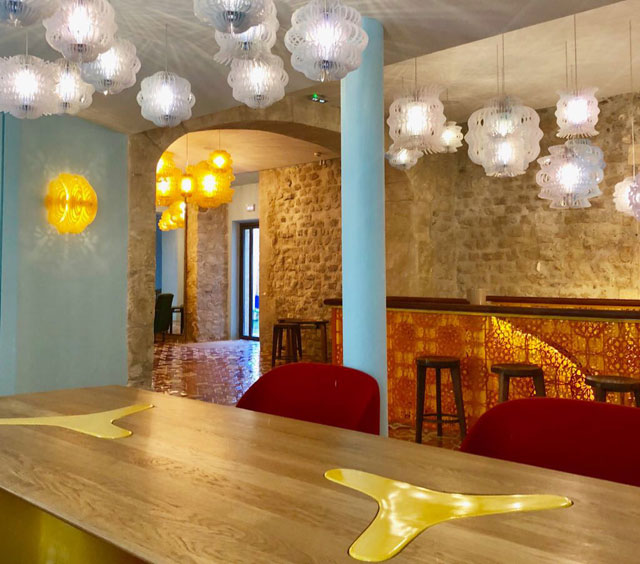
Jorge Pardo, hotel L’Arlatan, Arles, bar. Photo: Hervé Hote.
VS: But allowing people to use items from her own private collection in a public setting taps into your own interest in exploring or exploding the ideas of what is public or private, the conflict between public and domestic space.
JP: it is a really interesting way to put into play that kind of history, of collecting and of hospitality. It’s not normal. People wouldn’t spend a lot of energy and time collecting this stuff and then putting it in their hotel.

Jorge Pardo, hotel L’Arlatan, Arles, bar. Photo: Hervé Hote.
VS: You are always being linked with Nicolas Bourriaud’s relational aesthetics movement – seeing art as part of a wider network of things, an information exchange between artist and viewer. And after spending time in the hotel, I noticed this creeping awareness of familiarity and connectivity between the colours and patterns and materials you had used and those in the streets around the hotel. Were these associations with the surroundings deliberate?
JP: I wanted the … colour and palette of the project to be so comprehensive that it would start to swallow things around it. I wasn’t thinking about how much of it was a referential machine. I thought if we have enough relationships in there, whatever you bring to it you will have a home for it. I am not the kind who likes to research, I’m more intuitive. The colour had to function more like a painting: it had to come from a set of relations that were designed within it, not through anecdotal storytelling.
Relational aesthetics? I’m not even sure what is meant by that. I believe in contingencies … I like the idea that artworks are like these contingency machines: the more you make, the longer they stay alive. They are not referential machines … A reference is about stabilising the meaning of something over and over again. It’s a didactic operation. My generation was sick of that kind of art, we wanted to devise methodologies and structures that work with things that are more open and function like the world functions. That might be one way to start thinking about it.
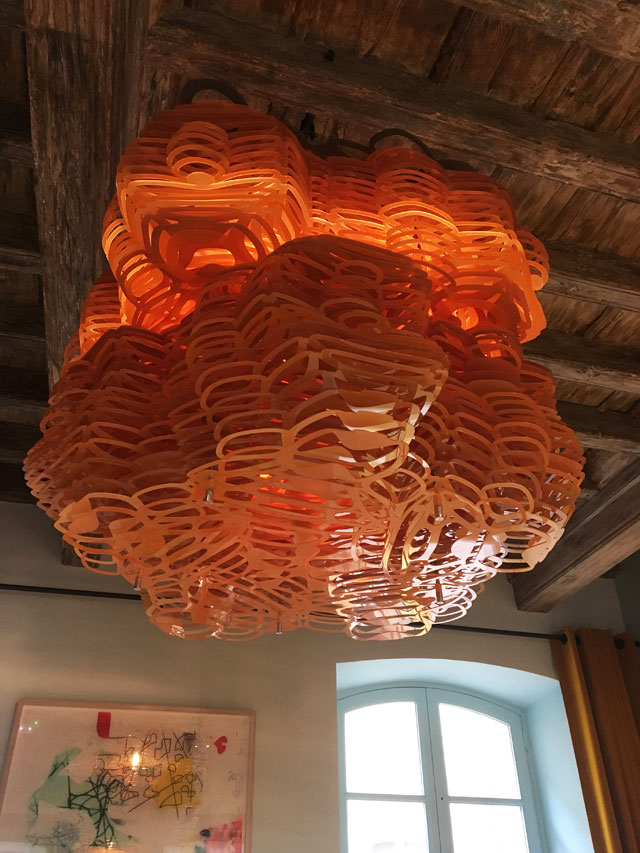
Jorge Pardo, hotel L’Arlatan, Arles, chandelier. Photo: Veronica Simpson.
What I always try to stay away from is the conservative side of conceptual art, the didactic, instructive side: the No that Knows. There’s a lot of No in conceptual art. I’m interested in Yes and More.
I didn’t want L’Arlatan to be a place of rest. I wanted it to be a place you would be immersed in. But my intentions are not as important as providing an object one could get lost in.
VS: Would you be interested in working on this scale again?
JP: These things don’t come by very often. We have a bunch of shows we’re working on. But this was an amazing opportunity. There aren’t too many Maja Hoffmanns in the world. She’s very special. She’s not a collector, she’s not a flipper. She’s going through life trying to do good with what she has.
VS: On that subject, one of the last nice surprises was realising how inexpensive the hotel can be to stay in – at low season, the cheapest double room costs less than €100.
JP: That was always something that there was an issue with. Maja wanted it to be accessible. And then the people who run the hotel were like … we have to charge more. At the end of the day, it’s priced so that the experience of being there can be shared by more people, not fewer.